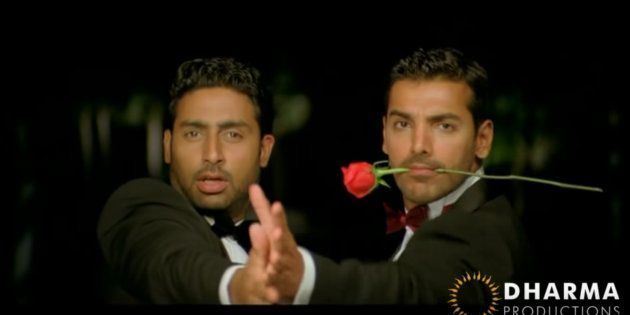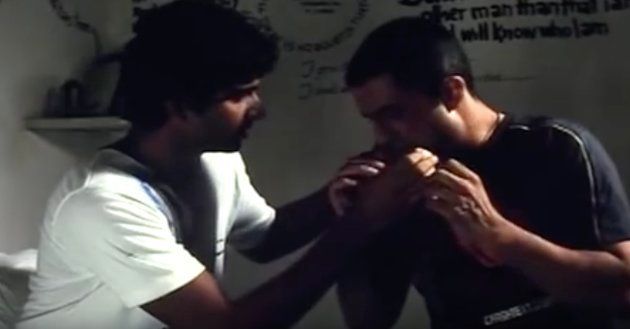
As I tried to explain who Kantaben was — the character in Kal Ho Naa Ho who throws a fit at the sight of two men showing affection to each other — Rohan, a New York-based actor and filmmaker cut in, "You saw that in a movie? It happened to me in real life."
Rohan, who did not want his last name to be used for this story, spent his teenage years in Chennai. He remembered a trip he made to the beach with his classmates. When the 15-year-old boys got into a playful fight and rolled around in the sand, the guard from a nearby building rushed to stop them, saying, "What are you doing, this is not allowed in India!"
The 28-year-old gay actor's experience would probably suggest that films do take inspiration from real-life human responses, but when it comes to mainstream Bollywood, it seems to have been fixated on the likes of Kantaben for too long to look at other reactions and paradigms of the queer community in India.
For example, the audience is expected to find Kantaben's reaction comical because she was merely over-reacting to completely non-sexual interactions between two heterosexual male characters. The same film also featured a gay White wedding planner who constantly draped himself over the 'heroes' without their consent.
Compared to a nuanced, hundreds of pages long court judgment, films and television reach a massive number of people making them powerful tools to influence any social narrative.
For years, Bollywood viewers who grew up in the '80s and '90s had to point to My Brother Nikhil (2005), directed by Onir, as the only legitimate representation of a homosexual relationship in mainstream Hindi cinema. Then, in 2016, Fawad Khan starred in Shakun Batra's Kapoor and Sons as a gay man. Earlier this year, Shashanka Ghosh's Veere Di Wedding had a gay couple as a part of the motley characters surrounding the lead actors.

In Kapoor and Sons, homosexuality is presented simply as a fact, and the audience is not shown scenes of the gay characters interacting with each other. Even when Ratna Pathak Shah's character stumbles upon photos of her gay son and his boyfriend, the photos show the duo simply smiling at the camera, with little physical proximity. That said, Batra's sensitive, informed portrayal of a gay man hiding his sexuality from his family struck a chord with the queer community. Premankur Biswas, a queer journalist, said, " It plays on the straight-acting gay man prototype. As in, it plays safe. He could have been a flamboyant gay man but he isn't, probably because that would take away from the plot."
JOKERS AND CARICATURES
Ikshaku, a lawyer and drag queen who goes by the stage name Kushboo, said that the fact that mainstream movies completely ignored queerness made youngsters like him think that people were only allowed to grow up to be certain stereotypes.
"The joker was the closest representation of what one could call queer in these movies. Bright, colourful, funny, silly, bumbling and inevitably average-looking or short... nobody wanted to be the joker. Of course, I often felt most comfortable with that comical character or joker but that caricature was always and inevitably on the outskirts of the mainstream narrative," Ikshaku told HuffPost India. He added that these stereotypes affected how he saw himself in spaces that functioned on gender binaries and stereotypes — the classroom, the football field or the playground.
Actor Veeru Krishnan, who appeared in dozens of successful Bollywood films, mostly in the '90s, played 'feminised' male characters in various films, most significantly in Mahesh Bhatt's Hum Hain Rahi Pyar Ke and Dharmesh Darshan's Raja Hindustani. These characters — usually dance teachers — would usually be shown to be in a relationship with a 'masculine' woman and the ridicule they received from cis heteronormative characters in the film would provide the 'comic relief' for these films.
Sushmit Roy Chowdhury, who works for a multinational company in Bengaluru, said that while watching these films as a child and young adult, he often wondered whether he also came across like this to other people.
"These characters were also very vapid and had no other dimensions. So while I didn't try to behave differently, I tried to get people around me to notice other aspects about me, apart from my feminine demeanour," he told HuffPost India.
That movie (Dostana) just made a mockery of being gay.
While trans people and gay men are mocked, queer women are mostly absent from mainstream films. The rare occasion a mainstream film attempted to tackle the issue, a monstrosity called Girlfriend was made.
Megha Nandi, student and lesbian activist said that she always wondered why there was no queer women in Bollywood films she watched. "And there were these strange stereotypes like in Kuch Kuch Hota Hai. A tomboy will later become feminine as we know it, the man will then fall for her they will live happily ever after," she said.
"They used the lesbian theme to pander to straight male fantasy like porn does. And if that wasn't bad enough they painted Isha Koppikar's character as perverse, psychotic.. and someone who had 'turned into a lesbian' entirely because of a childhood trauma. It was offensive, tasteless, exploitative and downright yucky," said Aditi Jain, who is not queer but identifies herself as an ally. Nandi echoed her sentiments about 'Girlfriend'. "That movie was s***."
In 1996, Deepa Mehta's Fire, which showed two sisters-in-law from a traditional family falling in love with each other, led to violent protests.
That movie was sh**."
"People hadn't seen such a film — sadly, in these 20 years, hardly any films have been made on same-sex relationships. For India, it is definitely a landmark film," Nandita Das, who played one of the main characters, told Indian Expressin 2016.
Speaking on the condition of anonymity, several professionals working in film industries across the country said that during auditions, casting directors would refuse to consider a man as a heterosexual male character if they 'suspected' he was gay.
Ikshaku says he is "disgusted" by the popular representations of homosexuality in Bollywood. Karan Johar's Dharma Productions produced Nikhil Advani's Kal Ho Naa Ho and also Dostana, which is about two straight men pretending to be gay to rent an apartment. "That movie just made a mockery of being gay. The whole joke in the movie was that two straight men were pretending the gay. By the time I watched this movie, I was already exploring the nascent and underground queer culture in my city and was so quite disgusted with that portrayal," Ikshaku said.
REPRESENTATION AND RESPONSIBILITY
Rohan, the actor-filmmaker cited earlier, said that although he did not watch too many Bollywood films while growing up, the stereotyping of homosexual people is a problem across genres and extends to Hollywood as well. Growing up as queer teenager, he says, was lonely and anxiety-ridden but watching Will and Grace, which had Eric McCormack playing a gay man called Will Truman made up for the complete absence of queerness in other manifestations of popular culture around him. "Cinema and TV have a huge, huge role to play in normalising conversations about sexuality," he added.
The biggest benefit of overturning 377, and mainstreaming of queer/LGBTQ stories is that it encourages individuals to be themselves.
"The biggest benefit of overturning 377, and mainstreaming of queer/LGBTQ stories is that it encourages individuals to be themselves. It goes beyond just cinema and TV to Olympic medallists like Tom Daley and Gus Kenworthy (among many other athletes across various disciplines from WWE to football) being true to themselves while still doing what they love, and still be adored by their fans and teammates," Rohan told HuffPost India.
However, he added that as a gay actor, he constantly faces bias against homosexual men portraying heterosexual characters. "It's okay if a straight actor plays a gay man, but people won't cast a gay man as a straight character," he added.
Considering the amount of negative stereotyping Bollywood has subjected queer identities to, it probably needs to clean up its act and do its bit for the community outside niche films to be screened on Netflix. But Anubhav Chopra, a filmmaker based in Mumbai, said it cannot be just the film industry's responsibility to normalise conversations around queerness and people should just raise better children.
"Shakun Batra is known as a very sensitive filmmaker and Veere Di Wedding had Sonam Kapoor who is very committed to our rights, so the films reflected that. But at the end of the day, this is a business catering to a cross-section of people," he said. Chopra, unlike Ikshaku, prefers to call Dostana and Kal Ho Na Ho 'goofy'.
I am a human being! A whole person with my hopes, dreams, flaws, perfections, issues. That can't be compared to a movie character..." he said.